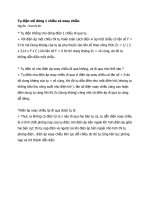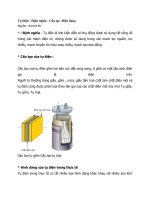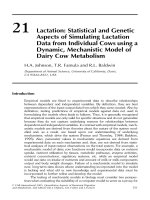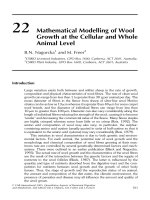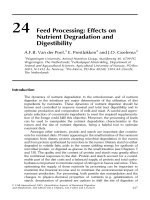Tài liệu Tự điển Food Science, Technology And Nutrition - Vần F pdf
Bạn đang xem bản rút gọn của tài liệu. Xem và tải ngay bản đầy đủ của tài liệu tại đây (237.4 KB, 25 trang )
exudative diathesis Vascular disease of vitamin e-deficient chicks,
characterised by accumulation of greenish fluid under the skin
of the breast and abdomen.
F
FAD See flavin adenine dinucleotide.
faeces Composed of undigested food residues, remains of diges-
tive secretions that have not been reabsorbed, bacteria from the
intestinal tract, cells, cell debris and mucus from the intestinal
lining, substances excreted into the intestinal tract (mainly in the
bile). The average amount is about 100 g/day, but varies widely
depending on the intake of dietary fibre.
faecolith Small hard mass of faeces, found especially in the
vermiform appendix.
faggot (1) Traditional British meatball made from pig offal and
meat.
(2) Bundle of herbs, see bouquet garni.
fair maids Cornish name for pilchards (thought to be a corrup-
tion of the Spanish fumade = smoked).
fairy potato See earth nut.
famotidine See histamine receptor antagonists.
FANSA The Food and Nutrition Science Alliance, a partnership
of the American Dietetic Association, the American Society for
Clinical Nutrition, the American Society for Nutritional Sciences
and the Institute of Food Technologists.
FAO Food and Agriculture Organization of the United Nations,
founded in 1943; headquarters in Rome. Its goal is to achieve
freedom from hunger worldwide. According to its constitution
the specific objectives are ‘raising the levels of nutrition and stan-
dards of living...and securing improvements in the efficiency
of production and distribution of all food and agricultural prod-
ucts.’ Web site />Farex
TM
A cereal food for infants.
farfals See pasta.
farina General term for starch. In UK specifically potato starch;
in the USA starch obtained from wheat other than durum
wheat; starch from the latter is semolina.Farina dolce is Italian
flour made from dried chestnuts.
farinaceous Starchy.
farinograph An instrument for measuring the physical properties
of a dough.
farl Scottish; triangular oatmeal cake.
fascioliasis Infestation of the bile ducts and liver with the liver
fluke Fasciola hepatica, commonly acquired by eating wild
181
watercress on which the larval stage of the parasite is
present.
fasciolopsiasis Infestation of the intestinal tract with the fluke
Fasciolopsis buski, commonly acquired by eating uncooked
water chestnuts contaminated with the larval stage of the
parasite.
fast foods (fast service foods) General term used for a limited
menu of foods that lend themselves to production line tech-
niques; suppliers tend to specialise in products such as ham-
burgers, pizzas, chicken or sandwiches.
fasting Going without food. The metabolic fasting state begins
some 4 h after a meal, when the digestion and absorption of food
are complete and body reserves of fat and glycogen begin to be
mobilised. In more prolonged fasting the blood concentration of
ketone bodies rises, as they are exported from the liver for use
by muscle and other tissues as a metabolic fuel.
fasting-induced adipocyte factor Circulating protein that inhibits
adipose tissue lipoprotein lipase, and so inhibits deposition of
lipid in adipose tissue.
fat (1) Chemically, fats (or lipids) are substances that are in-
soluble in water but soluble in organic solvents such as ether,
chloroform and benzene, and are actual or potential esters of
fatty acids.The term includes triacylglycerols (triglycerides),
phospholipids, waxes and steroids.
(2) In more general use the term ‘fats’ refers to the neutral fats,
which are esters of fatty acids with glycerol (triacylglycerols or
triglycerides).
fat, blood See lipids, plasma; lipoproteins, plasma.
fat, brown See adipose tissue, brown.
fat-extenders See fat, superglycinerated.
fat free EU regulations restrict use of the term ‘fat free’ to foods
that contain less than 0.15 g of fat/100g; in the USA low-fat foods
must state the percentage of fat; thus a product described as 95%
fat free contains only 5 g of fat/100g.
fat, high-ratio See fat, superglycinerated.
fat mouse Genetically obese mouse that secretes pro-insulin
because of a defect in the gene for the pro-insulin converting
enzyme, carboxypeptidase e.The same enzyme is also involved
in the post-synthetic modification of other peptide hormone
precursors, including pro-opiomelanocortin.
fat, neutral fats that are chemically triacylglycerols
(triglycerides).
fat, non-saponifiable, saponifiable See saponification.
fat, polymorphic One that can crystallise in more than one
form.
182
fat replacers Substances that provide a creamy, fat-like texture
used to replace or partly replace the fat in a recipe food. Made
from a variety of substances, e.g. Slendid is the trade name for a
product derived from pectin, Olestra is sucrose polyester which
is not absorbed by the body, Simplesse is a protein product,
N-oil is made from tapioca.
fat, saturated fats containing only or mainly saturated fatty
acids.
fat-soluble vitamins vitamins a, d, e and k; they occur in food dis-
solved in the fats and are stored in the body to a greater extent
than the water-soluble vitamins.
fat, superglycerinated Neutral fats are triacylglycerols, i.e. with
three molecules of fatty acid to each molecule of glycerol. Mono-
and diacylglycerols (sometimes called mono- and diglycerides)
are known as superglycerinated high-ratio fats or fat extenders
(E-471).
Glyceryl monostearate (GMS) is solid at room temperature,
flexible and non-greasy; used as a protective coating for foods, as
a plasticiser for softening the crumb of bread, to reduce spatter-
ing in frying fats, as emulsifier and stabiliser. Glyceryl mono-
oleate (GMO) is semiliquid at room temperature.
fatty acids Organic acids consisting of carbon chains with a ter-
minal carboxyl group. The nutritionally important fatty acids
have an even number of carbon atoms, commonly between 12
and 22. Saturated fatty acids are those in which there are only
single bonds between adjacent carbon atoms. It is recommended
that intake should not exceed about 10% of food energy intake,
since they increase levels of low-density lipoprotein cholesterol
(a major risk factor in heart disease).
Unsaturated fatty acids have one or more carbon–carbon
double bonds in the molecule. These double bonds can be
reduced (saturated) with hydrogen, the process of hydrogena-
tion, forming saturated fatty acids. Fatty acids with only one
double bond are termed mono-unsaturated; oleic acid is the
main one found in fats and oils. Fatty acids with two or more
double bonds are termed polyunsaturated fatty acids, often
abbreviated to PUFA.
Unsaturated fatty acids reduce the concentration of LDL cho-
lesterol in the blood. In general, fats from animal sources are
high in saturated and relatively low in unsaturated fatty acids;
vegetable and fish oils are generally higher in unsaturated and
lower in saturated fatty acids.
In addition to their systematic and trivial names, fatty acids
can be named by a shorthand giving the number of carbon atoms
in the molecule (e.g. C18), then a colon and the number of double
183
bonds (e.g. C18:2), followed by the position of the first double
bond from the methyl end of the molecule as n- or ω (e.g. C18:2
n-6, or C18:2 ω6). See Table 8 of the Appendix.
fatty acids, essential (EFA) fatty acids that cannot be made in
the body and are therefore dietary essentials – two polyunsatu-
rated fatty acids: linoleic (C18:2 ω6) and α-linolenic (C18:3 ω3).
Several other fatty acids have some EFA activity in that they
cure some, but not all, of the signs of (experimental) EFA defi-
ciency. Arachidonic (C20:4 ω6), eicosapentaenoic (EPA C20:5
ω3) and docosahexaenoic (DHA C22:6 ω3) acids are physiolog-
ically important, although they are not dietary essentials since
they can be formed from linoleic and α-linolenic acids.
Estimated average requirement for ω6 PUFA is 1% of total
energy intake (260 mg/MJ) and for ω3 PUFA is 0.2% (50 mg/MJ),
with a recommendation that total PUFA intakes should not
be more than 10–15% of total energy; a desirable intake, and the
basis of reference intakes,is 8–10% of energy intake, about
2–2.6 g/MJ.
fatty acids, free (FFA) or non-esterified (NEFA) Fatty acids may
be liberated from triacylglycerols (triglycerides) either by
enzymic hydrolysis (when they are generally known as non-
esterified fatty acids, NEFA, or unesterified fatty acids, UFA) or
as a result of hydrolytic rancidity of the fat. Determination of
NEFA is therefore an index of the quality of fats.
Free fatty acids circulate in the bloodstream, bound to
albumin. They are released from adipose tissue in the fasting
state, as a fuel for muscle and other tissues. The normal concen-
tration in plasma is between 0.5 and 2 µmol/L, increasing with
fasting and exercise.
fatty acids, polyunsaturated Long-chain fatty acids containing
two or more double bonds, separated by methylene bridges:
—CH
2
—CH
=
CH — CH
2
—CH
=
CH — CH
2
—.
fatty acids, unesterified, non-esterified (NEFA) See fatty acids,
free.
fatty acids, volatile Short-chain fatty acids, acetic, propionic and
butyric, which, apart from their presence in some foods, are
produced by bacteria in the human intestine and rumen of
cattle from undigested starch and dietary fibre.To some
extent they can be absorbed and used as a source of energy.
Butyric acid formed in the colon may have some anticarcino-
genic action, and is a significant metabolic fuel for colonic
enterocytes.
fat, unsaturated fats containing a high proportion of unsaturated
fatty acids.
fat, yellow See spread, fat.
184
favism Acute haemolytic anaemia induced in genetically sensitive
people by eating broad beans, Vicia faba, or in response to various
drugs, including especially antimalarials. The disease is due to a
deficiency of the enzyme glucose6-phosphate dehydrogenase
(EC 1.1.1.19) in red blood cells, which are then vulnerable to the
toxins, vicine and convicine, in the beans. The condition affects
some 100 million people worldwide, and is commonest in people
of Mediterranean and Afro-Caribbean descent.
FDA US Food and Drug Administration, government regulatory
agency; web site web site for FDA consumer
magazine />FD&C USA; abbreviation for synthetic colours permitted for use
in food, drugs and cosmetics.
FDF Food and Drink Federation, organisation speaking for the
UK food and drink manufacturing industry; web site
/>FDNB See fluorodinitrobenzene.
fecula (fécule) Foods that are almost solely starch, prepared from
roots and stems by grating, e.g. tapioca, sago and arrowroot.
Starchy powder from rice, potatoes, etc.
feedback control Control of a process using information from
sensors to adjust the conditions.
Fehling’s reagent Alkaline cupric tartrate solution used for detec-
tion and semi-quantitative determination of glucose and other
reducing sugars.
See also benedict’s reagent, somogyi–nelson reagent.
feijoa Fruit of S American tree Acca sellowiana (formerly Feijoa
sellowiana), also known as pineapple guava, guaveasteen; mainly
grown in New Zealand.
Composition/100 g: (edible portion 75%) water 87 g, 205 kJ
(49 kcal), protein 1.2g, fat 0.8 g, carbohydrate 10.6g, ash 0.7 g, Ca
17 mg, Fe 0.1 mg, Mg 9 mg, P 20 mg, K 155 mg, Na 3 mg, Cu 0.1 mg,
Mn 0.1 mg, vitamin B
1
0.01 mg, B
2
0.03 mg, niacin 0.3 mg, B
6
0.05 mg, folate 38 µg, pantothenate 0.2 mg, C 20 mg.A 50 g serving
(1 fruit without refuse) is a source of vitamin C.
feijoa beans See bean, adzuki.
Feingold diet Exclusion of foods containing synthetic colours,
flavours and preservatives and limitation of intake of fruits and
vegetables such as oranges, apricots, peaches, tomatoes and
cucumbers; intended to treat hyperactive children. There is little
evidence either that these foods are a cause of hyperactivity or
that the exclusion diet is beneficial.
felafel Middle Eastern; deep fried balls of chickpea batter.
FEMA US Flavor and Extract Manufacturers’ Association, web
site aflavor.org/.
185
fenelar Norwegian; leg of mutton dry-brined with salt,
saltpetre and sugar, then in a sweet pickle, smoked and air
dried.
fenfluramine An anorectic (appetite suppressant, see appetite
control) drug with amphetamine-like actions formerly used in
the treatment of obesity; withdrawn in 1995 in response to
reports of heart valve damage (in the combined preparation with
phentermine, fen-phen). Only the d-isomer is active (dexfenflu-
ramine).
fennel (1) Aromatic seeds and feathery green leaves of the
perennial plant Foeniculum vulgare, used to flavour a variety of
dishes.
(2) Foeniculum dulce (or F. vulgare var. azoricum). Annual
plant, also called Florence fennel or finnochio; the swollen bases
of the leaves are eaten as a vegetable, raw or cooked. The seeds
are also used as flavouring.
Composition/100 g: (edible portion 72%) water 90.2 g, 130 kJ
(31 kcal), protein 1.2 g, fat 0.2 g, carbohydrate 7.3 g, fibre 3.1 g, ash
1g,Ca 49 mg, Fe 0.7 mg, Mg 17 mg, P 50mg, K 414mg, Na 52 mg,
Zn 0.2 mg, Cu 0.1 mg, Mn 0.2 mg, Se 0.7 µg, vitamin A 7 µg RE B
1
0.01 mg, B
2
0.03 mg, niacin 0.6 mg, B
6
0.05 mg, folate 27 µg, pan-
tothenate 0.2 mg, C 12 mg. A 110 g serving (half bulb) is a source
of folate, a good source of vitamin C.
fen-phen The combination of fenfluramine and phentermine,
formerly used as an appetite suppressant (appetite control)
drug in the treatment of obesity; withdrawn in 1995 in response
to reports of heart valve damage.
fenugreek Trigonella feonumgraecum,a leguminous plant eaten
as a vegetable; the seeds are used for flavouring. Traditionally
eaten by women in Asia to help gain weight.
fermentation Anaerobic metabolism. Used generally of alcoholic
fermentation of sugars, also production of acetic, lactic, and citric
acids by micro-organisms in pickling and manufacture of
vinegar.
fermentation, secondary In wine making; may be addition of
further sugar and yeast to produce carbon dioxide for sparkling
wines, or a malo-lactic fermentation using Lactobacillus spp. to
convert sharp-tasting malic acid to the milder lactic acid; again
this produces carbon dioxide, characteristic of pétillant (lightly
sparkling) wines.
See also vinegar.
fermented milk See milk, fermented.
fermentograph An instrument for measuring the gas-producing
power of a dough. The fermenting dough is contained in a
balloon immersed in water and as gas is produced the balloon
186
expands and rises in the water, the rise being measured
continuously.
ferric ammonium citrate The form in which iron is sometimes
added to foods. Occurs as brown-red scales (16.5–18.5% iron)
and as green scales (14.5–16% iron).
ferritin The main iron storage protein in tissues; also found in
serum, where the concentration reflects the total amount of
storage iron in the body, and therefore permits assessment of
iron status over the range from deficiency, through normal to
overload. Although it provides the most sensitive index of iron
depletion, its synthesis is also significantly reduced in response
to trauma and infection.
See also acute phase proteins; transferrin receptor.
ferrous gluconate iron salt of gluconic acid, used in iron sup-
plements and as a colouring agent in olives.
ferrum redactum See iron, reduced.
FFA Free fatty acids, see fatty acids, free.
FIAF See fasting-induced adipocyte factor.
fibre, crude The term given to indigestible part of foods, defined
in the UK Fertiliser and Feedingstuffs Act of 1932 as the residue
left after successive extraction under closely specified conditions
with petroleum ether, 1.25% sulphuric acid and 1.25% sodium
hydroxide, minus ash. No relationship to dietary fibre (see fibre,
dietary).
fibre, dietary Material mostly derived from plant cell walls which
is not digested by human digestive enzymes but is partially
broken down by intestinal bacteria to volatile fatty acids that
can be used as a source of energy. A large proportion consists of
non-starch polysaccharides; these include soluble fibre that
reduces levels of blood cholesterol and increases the viscosity of
the intestinal contents and insoluble fibre (cellulose and cell
walls) that acts as a laxative. Earlier known as roughage or bulk.
fibre, insoluble The part of dietary fibre (or non-starch poly-
saccharide) that is not soluble in water – cellulose, hemicel-
luloses and lignin. These increase the bulk of the intestinal
contents.
fibre, soluble The plant gums and small oligosaccharides in
dietary fibre (or non-starch polysaccharide) that are soluble
in water, forming viscous gels.
fibric acids A variety of analogues of clofibric acid (chlorophenoxy-
isobutyrate), including bezafibrate, clofibrate (the ethyl ester),
fenofibrate and gemfibrozil (which is not halogenated), used in
treatment of hyperlipidaemia.They lower vldl and ldl,and raise
hdl, by stimulation of lipoprotein lipase (EC 3.1.1.34).
fibrin See fibrinogen.
187
fibrinogen One of the proteins of the blood plasma responsible
for coagulation.When prothrombin is activated to thrombin in
response to injury, it hydrolyses fibrinogen to fibrin, which is
deposited as strands that trap red cells and platelets, forming the
clot.
fibronectin A plasma protein that has a very rapid rate of
turnover, and can be used as an index of undernutrition.
fibrous proteins See albuminoids.
ficin (ficain) Proteolytic enzyme (EC 3.4.22.3) from the fig.
fiddleheads See bracken.
field egg See aubergine.
field mushroom Agaricus campestris, A. vaporarius, see
mushrooms.
fig The fruit of Ficus carica; eaten fresh or dried. Figs have mild
laxative properties, e.g. syrup of figs is a medicinal preparation.
Composition/100 g: (edible portion 99%) water 79.1 g, 310 kJ
(74 kcal), protein 0.8g, fat 0.3 g, carbohydrate 19.2 g (16.3 g
sugars), fibre 2.9 g, ash 0.7g, Ca 35 mg, Fe 0.4 mg, Mg 17 mg, P
14 mg, K 232 mg, Na 1mg, Zn 0.2 mg, Cu 0.1 mg, Mn 0.1mg, Se
0.2 µg, vitamin A 7 µg RE (94 µg carotenoids), E 0.1 mg, K 4.7 mg,
B
1
0.06 mg, B
2
0.05 mg, niacin 0.4 mg, B
6
0.11 mg, folate 6 µg,
pantothenate 0.3 mg, C 2 mg.
fig, Adam’s See plantain.
fig, berberry or Indian See prickly pear.
FIGLU test For folic acid status. Measurement of urinary excre-
tion of formiminoglutamate (FIGLU) after a test dose of 2–5 g
of histidine. FIGLU formiminotransferase (EC 2.1.2.5) is a
folate-dependent enzyme.
See also anaemia, megaloblastic.
filbert See hazel nut.
filé powder Dried powdered young leaves of the sassafras tree
(Sassafras albidum); very aromatic, an ingredient of gumbo.
filo pastry See phyllo pastry.
filter cake Solid matter retained after filtration of a liquid.
filter mat drying Partially spray-dried material (about 20% mois-
ture) is allowed to fall onto a perforated belt through which air
is passed to complete the drying process.
Filtermat
TM
process For agglomeration of dried foods; the
product is partially dried by spray drying, then deposited onto a
perforated belt and dried further. There is sufficient moisture
in the intermediate product for agglomerates to form on the
belt.
filter medium See filtration.
filth test Name given to a test that originated in the USA for
determining the contamination of a food with rodent hairs and
insect fragments as an index of hygienic handling.
188
filtrate The liquid that passes through a filter; see filtration.
filtrate factor Obsolete name for pantothenic acid.
filtration The separation of solids from liquids by passing the
mixture through a bed of porous material (the filter medium),
either under gravity and hydrostatic pressure alone or using
pressure above, or vacuum below, to force the liquid through the
filter bed.
See also filter cake; filtrate.
fines herbes Mixture of chopped parsley, tarragon, chives, chervil,
marjoram and sometimes watercress.
fingerware Edible seaweed, Laminaria digitata.
fining agents Substances used to clarify liquids by precipitation,
e.g. egg albumin, casein, bentonite, isinglass, gelatine.
finnan haddock Smoke-cured haddock (named after Findon in
Scotland).
See also arbroath smokie.
finocchio Variety of fennel with swollen leaf base; Foeniculum
vulgare var. azoricum.
fire point The temperature at which a frying oil will sustain com-
bustion; between 340 and 360 °C for most fats.
See also flash point; smoke point.
fireless cooker See haybox cooking.
firkin A quarter of a barrel of beer, 9 Imperial gallons (40 L); also
56 lb (25.5 kg) of butter.
firming agents Fresh fruits contain insoluble pectin as a gel
around the fibrous tissues which keeps the fruit firm. Breakdown
of cell structure allows conversion of pectin to pectic acid, with
loss of firmness. The addition of calcium salts (chloride or car-
bonate) forms a calcium pectate gel which protects the fruit
against softening; these are known as firming agents. Alum (alu-
minium potassium sulphate) is sometimes used to firm pickles.
FISH Fluorescent in situ hybridisation, a technique for locating
specific regions of DNA in a chromosome using a fluorescently
labelled DNA probe.
fish days Historical; days on which fish, but not meat, could be
eaten. Originally decreed by the Church (Fridays, fast days and
throughout Lent); more were decreed in England during the 16th
century, both to encourage ship building and the training of
mariners, and also, because of the shortage of meat, to permit an
increase in the numbers of cattle. The Vatican rescinded the rule
forbidding Catholics to eat meat on Fridays in 1966.
fish, demersal Fish species living on or near the sea bed – the
white (non-oily) fish such as cod, haddock, halibut, plaice, sole
and whiting. Caught by trawls which are dragged along the
bottom of the sea, or seine nets. Known in USA as ground fish.
See also fish, white.
189
fish, fatty See fish, oily.
fish flour See fish protein concentrate.
fish ham Japanese product made from a red fish such as tuna or
marlin, pickled with salt and nitrite, mixed with whale meat and
pork fat and stuffed into a large sausage-type casing.
fish meal Surplus fish, waste from filleting (fish-house waste)
and fish unsuitable for human consumption are dried and pow-
dered. The resultant meal is a valuable source of protein for
animal feedingstuff, or, after deodorisation, as human food
since it contains about 70% protein. Meal made from white fish
is termed white fish meal, distinct from the oily type which
is sometimes of very poor quality and is used mainly as
fertiliser.
fish odour syndrome See trimethylamine.
fish oils These contain long-chain polyunsaturated fatty acids
which offer some protection against heart disease. The two
main ones are eicosapentaenoic acid (EPA C20:5 ω3) and
docosohexaenoic acid (DHA C22:6 ω3). Fish oil concentrates
containing these fatty acids are sold as pharmaceutical
preparations.
See also cod liver oil; halibut; menhaden.
fish, oily anchovy, herring, mackerel, pilchard, salmon,
sardine, trout, tuna, whitebait, containing about 15% fat
(varying from 5 to 20% through the year) and containing 10–
40 µg vitamin D per 100 g, as distinct from white fish, which
contain 1–2% fat and only a trace of vitamin D.
See also fish, pelagic.
fish paste A spread made from ground fish and cereal. In UK,
legally contains not less than 70% fish.
fish, pelagic Literally ‘of or pertaining to the ocean’ – fish nor-
mally caught at or near the surface of the sea. Mainly the migra-
tory, shoaling, seasonal fish; oily fish (see fish, oily) such as
herring, mackerel, pilchard and tuna.
fish protein concentrate Deodorised, decolorised, defatted fish
meal, also known as fish flour.
fish solubles See stickwater.
fish tester Instrument for assessing the freshness of fish by mea-
suring dielectric properties of skin and muscle, developed as the
GR Torrymeter by the (now disestablished) Torry Research
Station in Scotland.
fish, white Non-oily fish, e.g. cod, dogfish, haddock, halibut,
plaice, saithe, skate, sole, whiting. See fish, demersal.
fistula An abnormal connection between two hollow organs, or
between a hollow organ and the external environment; may
occur as a result of infection, injury or surgery.
190


